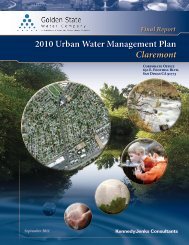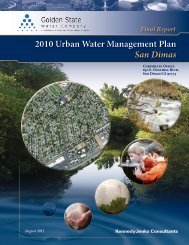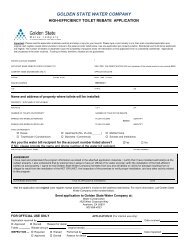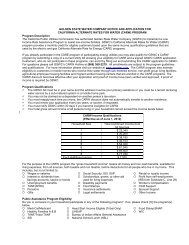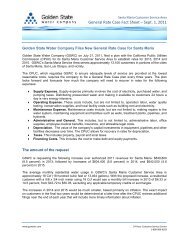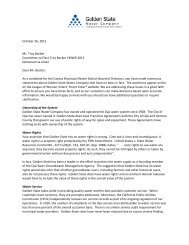Final Report, 2010 Urban Water Management Plan - Culver City
Final Report, 2010 Urban Water Management Plan - Culver City
Final Report, 2010 Urban Water Management Plan - Culver City
You also want an ePaper? Increase the reach of your titles
YUMPU automatically turns print PDFs into web optimized ePapers that Google loves.
3.8 Disadvantaged Community <strong>Water</strong> Use ProjectionsSection 10631.1 (a). Include projected water use for single-family and multi-family residential housing neededfor lower income households, as identified in the housing element of any city, county, or city and county in theservice area of the supplier.Senate Bill 1087 requires that water use projections of a UWMP include the projected water usefor single-family and multi-family residential housing for lower income households as identifiedin the housing element of any city, county, or city and county in the service area of the supplier.Housing elements rely on the Regional Housing Needs Allocation (RHNA) generated by theState Department of Housing and Community Development (HCD) to allocate the regional needfor housing to the regional Council of Governments (COG) (or a HCD for cities and counties notcovered by a COG) for incorporation into housing element updates. Before the housing elementis due, the HCD determines the total regional housing need for the next planning period for eachregion in the state and allocates that need. The COGs then allocate to each local jurisdiction its“fair share” of the RHNA, broken down by income categories; very low, low, moderate, andabove moderate, over the housing element’s planning period.The County of Los Angeles last updated its housing element in 2006. A lower income house isdefined as 80 percent median income, adjusted for family size. The County’s housing elementidentifies the target number of low-income households in the County from 2006 to 2013 as 15.7percent and very low-income households as 24.7 percent. However, it is unknown whatpercentage of the low-income and very low-income households are within GSWC’s <strong>Culver</strong> <strong>City</strong>service area. For this reason, it is not possible to project water use for lower income householdsseparately from overall residential demand. However, to remain consistent with the intent of theSB-1087 legislation and to comply with the UWMP Act, an effort has been made to identifythose water use projections for future single and multi-family households based on theaggregate percentage of both the low-income and very low-income categories. 40 percent wasused to estimate the lower income demand projections as shown in Table 3-16 below.Table 3-16:Low-Income Projected <strong>Water</strong> Demands in ac-ft/yr2015 2020 2025 2030 2035Single -Family Residence 146 159 170 180 189Multi-Family Residence 93 102 109 116 121Total 239 261 279 296 310Note:This table is based on the DWR Guidebook Table 8.Page 3-16<strong>Final</strong> <strong>Report</strong>, <strong>2010</strong> <strong>Urban</strong> <strong>Water</strong> <strong>Management</strong> <strong>Plan</strong> – <strong>Culver</strong> <strong>City</strong>Golden State <strong>Water</strong> Companyg:\adminasst\jobs\<strong>2010</strong>\1070001.00_gswc-uwmp\09-reports\9.09-reports\2011-08\grp3\gswc_culvercity_<strong>2010</strong>_uwmp-final.doc




